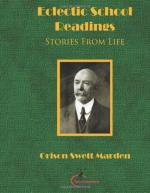The British commander agreed to release Dr. Beanes, but would not permit Key and his party to return then, lest they should carry back important information to the American side. He boastingly declared, however, that the defense could hold out only a few hours, and that Baltimore would then be in the hands of the British.
Skinner and Key were sent on board the Surprise, which was under the command of Admiral Cockburn’s son. But after a short time they were allowed to return to their own vessel, and from its deck they saw the American flag waving over Fort McHenry and witnessed the bombardment.
All through the night the furious attack of the British continued. The roar of cannon and the bursting of shells was incessant. It is said that as many as fifteen hundred shells were hurled at the fort.
Shortly before daybreak the firing ceased. Key and his companions waited in painful suspense to know the result. In the intense silence that followed the cannonading, each one asked himself if the flag of his country was still waving on high, or if it had been hauled down to give place to that of England. They strained their eyes in the direction of Baltimore, but the darkness revealed nothing.
At last day dawned, and to their delight the little party saw the American flag still floating over Fort McHenry. Key’s heart was stirred to its depths, and in a glow of patriotic enthusiasm he immediately wrote down a rough draft of “The Star-spangled Banner.”
On his arrival in Baltimore he perfected the first copy of the song, and gave it to Captain Benjamin Eades, of the 27th Baltimore Regiment, saying that he wished it to be sung to the air of “Anacreon in Heaven.” Eades had it put in type, and took the first proof to a famous old tavern near the Holliday Street Theater, a favorite resort of actors and literary people of that day. The verses were read to the company assembled there, and Frederick Durang, an actor, was asked to sing them to the air designated by the author. Durang, mounting a chair, sang as requested. The song was enthusiastically received. From that moment it became the great popular favorite that it has ever since been, and that it will continue to be as long as the American republic exists.
Key died in Baltimore on January 11, 1843. A monument was erected to his memory by the munificence of James Lick, a Californian millionaire. The sculptor to whom the work was intrusted was the celebrated W. W. Story, who completed it in 1887. The monument, which is fifty-one feet high, stands in Golden Gate Park, San Francisco. It is built of travertine, in the form of a double arch, under which a bronze statue of Key is seated. A bronze figure, representing America with an unfolded flag, supports the arch.
On the occasion of the unveiling of this statue, the New York Home Journal contained an appreciative criticism of Key as a poet, and the following estimate of his greatest production.




